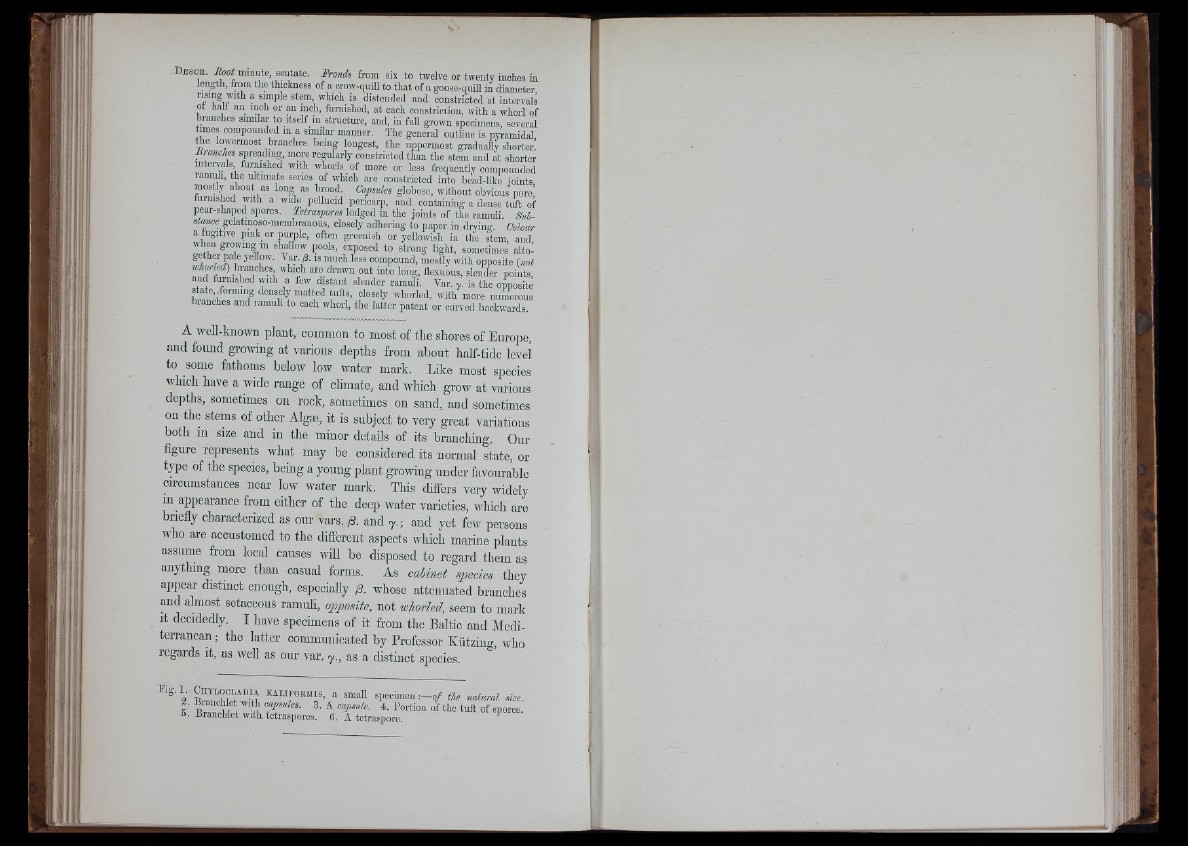
a ii i
D e sc r . Root minute, scutate. Fronds from six to twelve or twenty inches in
length, fi-om the thickness of a crow-quill to that of a goose-quill in diameter
rising with a simple stem, which is distended and constricted at intervals
of half an inch or an inch, furnished, at each constriction, with a whorl of
branches similar to itself in structure, and, in full grown specimens, several
times compounded m a similar manner. The general outline is pyramidal,
the lowermost branches being longest, the uppermost gradually shorter.
Branches spreading, more regularly constricted than the stem and at shorter
intervals furmslied with whorls of more or less frequently compounded
ramidi, the ultimate series of which are constricted into he'ad-like ioints,
mostly about as long as broad. CapsuUs globose, without obvious pore,
furnished with a wide pellucid pericarp, and containing a dense tuft of
pear-shaped spores. Tetraspores lodged in the joints of the ramuli.
it e c e gelatmoso-membranous, closely adhering to paper in drying. Colour
a fugitive pink or puqile, often greenish or yellowish in the stem, and
when growing in siallow pools, exposed to strong light, sometimes alto-
gethei pale yellow. Var. is much less compound, mostly with opposite {not
w M e d ) branches which are drawn out into long, flexuous, slender points,
and furnished with a few distant slender ramuli. Var. y. is the o]iposit^
s ate, forming densely matted tufts, closely whorled, with more numerous
blanches and ramuh to each whorl, the latter patent or curved backwards.
A well-known plant, common to most of the shores of Europe,
and found growing at various depths from about half-tide level
to some fathoms below low water mark. Like most species
which have a wide range of climate, and which grow at various
depths, sometimes on rock, sometimes on sand, and sometimes
on the stems of other Algte, it is subject to very great variations
both m size and in the minor details of its branching. Our
figure represents what may be considered its normal state, or
type of the species, being a young plant growing under favourable
circumstances near low water mark. This differs very widely
in appearance from either of the deep water varieties, which are
briefiy characterized as our vars. /9. and y.- and yet few persons
who are accustomed to the different aspects which marine plants
assume from local causes will be disposed to regard them as
anything more than casual forms. As cabinet spjecies they
appear distinct enough, especially /3. whose attenuated branches
and almost setaceous ramuli, opposite, not whorled, seem to mark
It decidedly. I have specimens of it from the Baltic and Mediterranean
; the latter communicated by Professor Kiitzing, who
regards it, as well as our var. y., as a distinct species.
' ' i j
iu
111
I II' '
f; i
^ '^ '■ 3 s p e c im e u :-« / the natural me.
5 ' Urnupfolf -o ^ 4- Portion of 5. -Hianchlet with tetraspores. 6. A tetraspore. the tuft of spores.